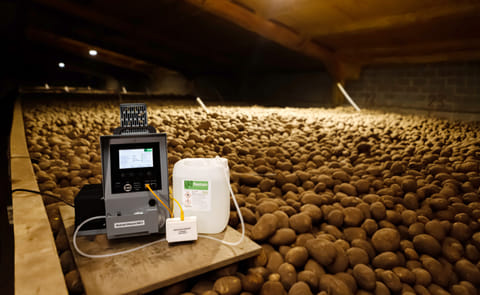NAPSO recaps highly successful webinar: In-depth insights into optimal potato storage practices
NAPSO recaps highly successful webinar: In-depth insights into optimal potato storage practices

The North America Potato Storage Organization (NAPSO) proudly hosted a comprehensive and insightful webinar on August 19, 2024, titled "Preparing for a Successful Storage Season." The event, facilitated by NAPSO Communications Coordinator Emily Merk, drew substantial interest, with over 60 professionals from various sectors of the potato industry in attendance.
Featuring expert presentations from Nathan Gelles of Decco Post-Harvest and Todd Forbush of Techmark, the webinar offered a deep dive into the strategies and best practices essential for maintaining optimal potato quality during storage. A recording of the webinar has been published on the NAPSO website and can be accessed on this page.
Nathan Gelles: The Critical Role of Sanitation and Early Storage Management
Nathan Gelles, an esteemed potato advisor with Decco Post-Harvest, began the session by underscoring the critical importance of early storage management and the integral role of sanitation in preserving tuber quality.
Nathan Gelles:
"Once the potato is removed from the vine, it is essentially a ticking time bomb."
Gelles asserted, emphasizing the need for proactive measures to combat decay and maintain potato quality throughout the storage season. Gelles highlighted that the primary objectives of potato storage revolve around preserving tuber quality for as long as possible, ensuring that the end user receives a product of the highest possible standard.
This, he noted, involves managing several factors simultaneously, including weight loss, sprout development, and the maintenance of end-use qualities such as color, sugar levels, and starch content. One of the key points Gelles focused on was the importance of disease control in storage.
Nathan Gelles:
"Anything we can do to minimize this decay process is going to help us store this product a lot longer and make a lot more money at the tail end of things."
He introduced various tools available for managing storage quality, such as sanitizers, disinfectants, fungicides, and sprout inhibitors, while emphasizing that proper storage management—specifically the control of temperature, humidity, and CO2 levels, along with adequate airflow—is paramount. Gelles took the opportunity to draw a powerful analogy, likening the storage of potatoes to securing a million-dollar investment.
Nathan Gelles:
"Why wouldn’t we treat our potatoes the same as a million-dollar cash prize that we have to keep safe for ten months?"
He emphasized that just as one would choose a clean, secure vault to store money, the same principle should apply to potato storage, where a clean and well-maintained environment is crucial to minimizing losses. Gelles delved into the specifics of storage sanitation, outlining a meticulous four-step process designed to eliminate pathogens and extend storage life. The steps included:
- Removing Gross Material: This involves clearing out all large foreign objects, dirt, and organic matter from the storage facility to prevent bacteria from finding a place to thrive.
- High-Pressure Washing with Soap and Detergent: This step is crucial for breaking down biofilms, particularly those formed by bacterial ring rot, which can survive on surfaces for several years. Gelles emphasized the importance of thoroughly cleaning all surfaces, including walls, ceilings, air ducts, and fan houses.
- High-Pressure Rinse and Steam Cleaning: Following the wash, a high-pressure rinse helps remove any remaining residues, with steam cleaning further enhancing the breakdown of biofilms and killing pathogens.
- Disinfection: The final step involves applying sanitisers to all surfaces, ensuring they remain wet for a minimum of 10 minutes to effectively kill pathogens. Gelles noted that the choice of sanitiser should be tailored to the specific pathogens and materials involved, and he stressed the importance of using clean water to avoid neutralizing the sanitizing agents.
Gelles also discussed the importance of proper storage maintenance, cautioning against neglecting the repair of cracks and crevices where pathogens could thrive. He advised the use of the high-pressure application and fogging sanitisers, particularly in challenging environments, to ensure comprehensive pathogen control.
Todd Forbush: Field Selection and Storage Potential – The 'Storage Signature'
Todd Forbush, a renowned expert from Techmark, followed with a detailed exploration of the factors influencing potato storage outcomes, focusing on the concept of the "storage signature" — a term he used to describe the chemical maturity of the crop as it enters storage. Forbush began by emphasizing the importance of understanding how various field conditions, including soil quality, variety selection, and weather patterns, affect the storage potential of potatoes.
Todd Forbush:
"We need to drill down on how these factors influence the genetic expression of that crop and its maturity point going into storage."
One of the critical aspects Forbush highlighted was the role of temperature and weather conditions during the growing season in shaping the storage potential of potatoes. He introduced the concept of cumulative growing degree days (GDD) as a tool for assessing how much heat the crop experienced and how this impacted its development.
Forbush noted that stressful days, particularly those with high nighttime temperatures, could significantly affect the crop’s storage behavior, leading to issues such as reduced tuber set or multiple sets in indeterminate crops.
Forbush also discussed the importance of monitoring sugar concentrations, specifically sucrose and glucose levels, to determine the maturity of potatoes before they enter storage.
Todd Forbush:
"One of the things we look at is the tuber sucrose rating, and then we compare that with the canopy vigor to get a feel for how the crop is maturing."
He warned that high nitrogen levels and environmental stressors like disease or drought could delay maturity, making it essential to assess the crop’s maturity before fall stresses, such as frost, could exacerbate storage challenges.
In addition to discussing pre-harvest practices, Forbush provided guidance on post-harvest management, particularly the importance of maintaining the right storage conditions to prevent quality deterioration. He advised that potatoes should be cooled gradually and stored at appropriate temperatures based on their maturity and intended market.
Todd Forbush:
"Cooling management is one of the pieces of the puzzle that we need to make sure we’re making an intentional decision with, not just cooling based on the calendar."
Forbush also emphasized the importance of continuous monitoring throughout the storage season. He recommended sampling sugars every two weeks during storage and weekly as the potatoes near senescence to ensure that quality remains stable or improves.
Todd Forbush:
"It’s important to know if the crop is improving or degrading in quality during storage."
He noted, adding that proper storage management can actually enhance the quality of potatoes, making them a better product than when they were first brought into storage.
Interactive Q&A and Positive Reception
The webinar, expertly facilitated by Emily Merk, concluded with a dynamic Q&A session, where attendees had the opportunity to engage directly with Gelles and Forbush. Participants raised questions on a range of topics, from the practical application of sanitizers to the nuances of sugar management in storage. Both experts provided thoughtful responses, further enriching the knowledge shared during the session.
Feedback from the attendees was overwhelmingly positive, with many praising the depth and clarity of the presentations. NAPSO expressed its satisfaction with the turnout and the quality of the discussions, noting that the event was a resounding success.
Addie Waxman, one the founders of NAPSO:
"We are thrilled with the level of engagement and the valuable insights shared by our expert speakers.This webinar has set a high standard for future events, and we are committed to continuing to provide industry professionals with the tools and knowledge they need to succeed."
Looking Ahead
The success of NAPSO’s inaugural webinar marks a significant milestone in the organization’s mission to advance storage practices within the North American potato industry. Building on the success of this webinar, NAPSO is planning a series of follow-up events aimed at further exploring the challenges and opportunities in potato storage management. The organization is committed to supporting the potato industry by fostering knowledge exchange and promoting best practices across all sectors.
As the challenges of potato storage become increasingly complex, NAPSO will remain a key resource, offering the expertise and support necessary to meet these challenges head-on. By providing a platform for expert knowledge sharing and industry collaboration, NAPSO is poised to play a pivotal role in helping growers and storage managers optimize their operations, ensuring both sustainability and profitability.










